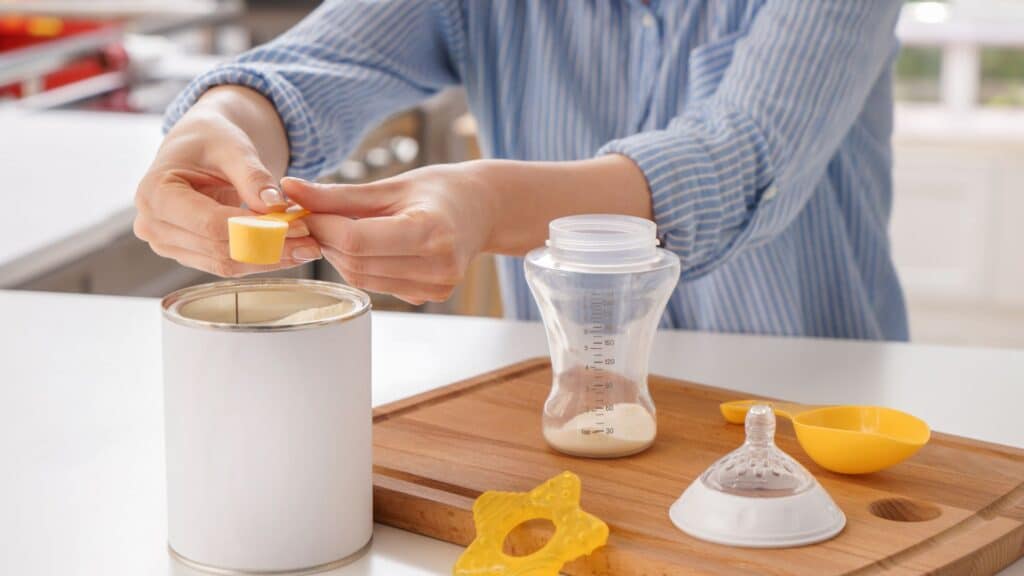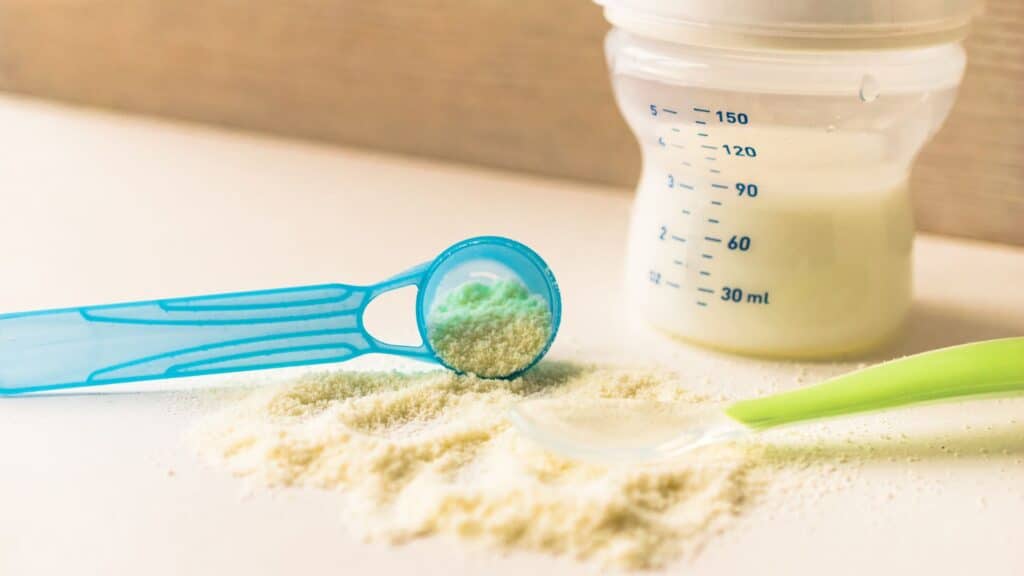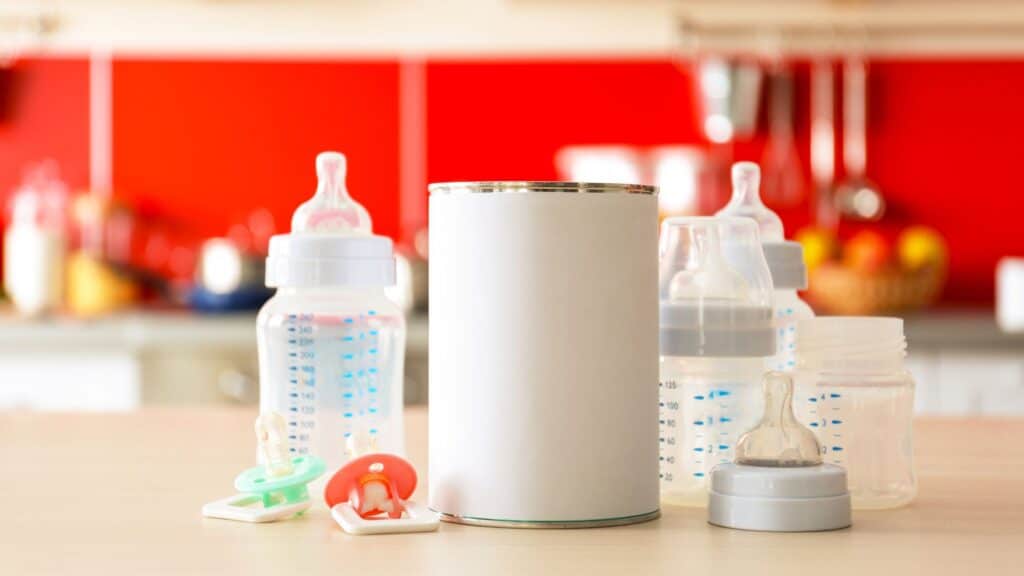Formula feeding is an important part of caring for a newborn baby. Whether you are formula feeding by choice or for medical reasons, it’s important to understand the different types of formula and how to prepare it safely and store it properly so that your baby gets all the nutrients they need.
This guide is for parents who choose formula feeding. It will cover all the aspects of formula feeding, including understanding different types of formula, preparing it safely and storing it properly, and feeding techniques.

Understanding Baby Formula Types
There are many different types of baby formula on the market. Some formulas are designed to be nutritionally similar to breast milk, while others have a more specialized purpose. Here are some of the most common types of baby formula:
There are four main types of baby formula:
Cow’s Milk-Based Formula
Cow’s milk-based infant formula powder is a popular choice for those who are formula-feeding their baby. The formula contains lactose, a natural sugar found in cow’s milk, and essential amino acids, fats, vitamins, and minerals that support normal growth in infants. For babies not breastfed or allergic to other formula types, cow’s milk-based formula is recommended. A prepared formula is a convenient option for those on the go. However, powdered infant formula is an economical option that can be mixed with water to make a warm formula for your baby.
Pros of Cow’s Milk-Based Formula:
- Cow’s milk is easy to digest and can help with digestive issues. It’s also a good source of protein and calcium.
- Cow’s milk is inexpensive.
- If your baby has a cow’s milk allergy, this is the only type of mixed formula that will work for them.
Cons of Cow’s Milk-Based Formula:
- Some babies won’t tolerate cow’s milk well; it can cause stomach pain, diarrhea, or constipation.
Soy-Based Formula
For infants who have difficulty digesting cow’s milk, soy-based formula is a viable alternative. This type of infant formula preparation can also serve as a vegan alternative to breast milk and contains many of the nutrients found in breast milk. However, it may be lacking in some fats critical for infant brain development.

Pros of Soy-Based Formula Powder:
- Soy-based formula contains all the essential fatty acids, proteins, vitamins, and minerals necessary for a baby’s growth and development.
- It is suitable for babies who have difficulty digesting lactose or milk proteins and is a good alternative for those with allergies to cows’ milk or milk proteins.
Cons of Soy-Based Formula Powder:
- Soy-based formula does not contain some important fats crucial for infant brain development, such as docosahexaenoic acid (DHA) and arachidonic acid (ARA).
- Some studies have suggested that high levels of phytoestrogens in the soy-based formula could potentially impact hormones and developmental processes in infants.
- Soy-based formula can be more expensive than cow’s milk-based formula.
Hydrolyzed Formulas
Hydrolyzed formulas are food made up of smaller molecules than regular foods. They are usually used in cases where the patient has trouble digesting or absorbing larger molecules, like protein.
Hydrolyzed formulas are made from proteins that have been broken down into smaller pieces. This can make it easier for your body to break them down into amino acids, which are the building blocks of protein.
Hydrolyzed formulas also have different flavors and textures than regular baby food, so if you’re looking for something similar to breast milk, this might be the way to go!

Pros of Hydrolyzed Formula:
- Hydrolyzed formula is ideal for babies with a history of cows’ milk protein allergy or intolerance, as it is less likely to cause an allergic reaction.
- It is also a good option for babies who experience digestive issues, such as colic, gas, or constipation, with other types of formula.
- Hydrolyzed formula is widely available and can be found in most grocery stores.
Cons of Hydrolyzed Formula:
- Hydrolyzed formula can be more expensive than other types of formula.
- It may have a different taste and smell than cow’s milk-based formula, which some babies may not like.
- Some babies may still experience an allergic reaction to hydrolyzed formula, even though it is less likely than with other formulas.
Specialty Formula
Specialty formulas are a type of infant formula that is designed for specific dietary needs, such as those for premature infants, low birth weight infants, or infants with digestive or metabolic disorders. Here are some pros and cons to consider:
Pros of Specialty Formula:
- Specialty formulas are specifically formulated to meet the unique nutritional needs of certain groups of babies.
- They are a good option for babies with specific health conditions or dietary restrictions, such as premature infants or those with digestive or metabolic disorders.
- Specialty formulas can be found in most grocery stores and are widely available.
Cons of Specialty Formula:
- Specialty formulas can be more expensive than other types of formulas.
- They may have a different taste and smell than cow’s milk-based formula, which some babies may not like.
- Some babies may still experience digestive issues, such as colic, gas, or constipation, even with specialty formulas.

It’s important to consult with a pediatrician to determine the best formula for your individual needs. In some cases, a specialty formula may be recommended, but in other cases, a different formula may be a better option.
Preparing Baby Formula Safely
When preparing infant formula, options include powder formula, liquid concentrate formula or concentrated liquid, and ready-to-feed formula. You might wonder how to prepare your baby’s formula safely and not make your baby sick. It’s not just a matter of putting the right ingredients together. It’s also about taking proper precautions to protect your baby from harm.
Here’s a step-by-step safe preparation for making a formula:
- Before handling the formula, wash your hands thoroughly with soap and water. You should also wash your hands after handling dirty dishes, diapers, or laundry that has come into contact with fecal matter.
- Clean all utensils, bottles, nipples, and other equipment that will come into contact with the formula by washing them in hot soapy water or running them through a dishwasher cycle with hot water and detergent.
- Boil all metal utensils for at least 10 minutes before using them to prepare the formula. This will kill any bacteria growing inside them from previous use.
- Mix the exact amount of water specified on your formula label (usually in ounces) with enough formula and stir until it dissolves completely into a smooth mixture. Avoid using more or less water than recommended. If you do not have enough powder to make up a full batch of formula, add extra water instead of increasing the amount of powder.
- Before the baby drinks the baby bottle, test the temperature of the formula by placing a few drops on the inside of your wrist. If it feels too hot, let it cool to body temperature or hold the bottle under cold running water or in an ice bath. Never microwave the formula, as this can create hot spots that can burn your baby’s mouth. Use the bottle of formula for one hour.
- After feeding, discard any leftover formula that your baby didn’t drink. Store unmixed powder in a sealed container in a cool, dry place, and always use the formula before its expiration date.
- If your baby becomes sick or has a weakened immune system, be sure to consult your local health department for advice on safe formula preparation and storage. Additionally, always wash your hands before handling your baby or their bottle, and avoid using bottle warmers, which can create hot spots and increase the risk of disease transmission.

Tips to Avoid Mistakes
When preparing infant formula, it’s important to follow a bottle-feeding formula preparation guide. This is to ensure your baby’s health and well-being.
A clean bottle is a must before adding the powder formula. Make sure to wash the bottle with warm water and soap, then rinse it with cold water to prevent the growth of bacteria. It’s important to keep in mind that if you are using tap water, boil it first or use boiled water that has cooled down and sit for 30 minutes before using it in preparing infant formula.
When bottled water, ensure that it has been refrigerated at all times, and never reuse a bottle with breast milk in it as there could be bacteria present. By following these tips as part of your bottle-feeding formula preparation guide, you can ensure that your baby’s mouth receives the safe and nutritious formula they need.
Storing Baby Formula
A lot of people are storing baby formula to save money, but what if you’re storing it in the wrong way? Here are a few tips to keep your baby’s food safe:
1. Don’t store it in the fridge! Instead, try keeping it at room temperature. It’s even better to store it in a cool basement or garage. That way, it stays fresher longer and tastes better when you go to feed your little one!
2. If you have to store your baby’s food in the fridge, make sure you use an airtight container with a lid on it—no exceptions! If there’s no lid on your container of formula, then air can get inside and spoil everything before you’re ready for mealtime with your little one.
3. Make sure containers holding formula are clean and sanitized before use. They should also be stored out of direct sunlight so they don’t get too hot or too cold while they sit on your kitchen countertop waiting for their next feeding time.
4. If you have to leave the formula in the car, ensure it’s cool and not exposed to direct sunlight for long periods (or at all).
5. Always check the expiration date on your baby’s food—even if you’ve stored it properly!

How to Tell if Formula has Gone Bad?
If you’re storing a formula, it’s important to know how to tell if it has gone bad. The formula that has been opened and left out for too long will start to smell sour and develop mold. If you can’t see any visible signs of mold or smell any unpleasant odors but think your formula is still good, try tasting a small amount of it. The formula should not taste sour or bitter; if it does, throw out the whole batch.
If you’re looking to store your formula, we recommend storing formula in the refrigerator and taking it out of the can before you’re ready to feed it.
When you remove a can from the fridge, make sure it’s sealed tightly and has not been punctured or damaged by other cans or food items.
After removing it from the fridge, hold the can upright for 30 seconds before opening it to allow any condensation that may have formed during storage to evaporate away from your baby’s food. If you open the can and see condensation, wait a few more minutes before feeding your baby.
Feeding Techniques
There are a variety of feeding techniques for babies, including bottle-feeding and breastfeeding.
The first step in feeding your baby is to set up the proper environment for feeding. This means finding a comfortable chair or couch to sit in, ensuring you have enough space for the baby to lie comfortably on their back if they’re older than 4 months old, and getting everything you need ready before you start. The next step is to feed your baby!
If you’re bottle-feeding your baby (using formula), fill up the bottle with water at room temperature and then add the formula until it reaches the amount of fluid ounces per day that your doctor has recommended for your baby’s age. Next, shake the bottle well so that all ingredients are incorporated together evenly before handing it off to your child.
If breastfeeding your child, position yourself so that both arms are free to hold onto them while simultaneously holding onto a pillow or something else that will provide support under their head if needed (for example: if they fall asleep). Make eye contact with them while holding one hand under their chin and gently pulling back on it slightly so that they open their mouth wide enough for you to put the nipple in. The other hand should be placed behind their head, supporting them from falling forward.
Once the baby latches on, ensure you don’t pull on them too hard by keeping your hands still until they get used to feeding from your breast. Then place your finger under their chin and lift it slightly, encouraging them to swallow instead of just sucking.

Conclusion
In conclusion, it is important to carefully prepare and store formula to promote optimal health outcomes for your baby. Always use fresh tap water, boil and cool it or use cooled boiled water to prepare powdered formula. Never use cold formula or add extra formula powder to compensate for a shortage of milk, as this can cause digestive issues and affect your baby’s immune system.
Warm bottles in a bowl of warm water and test the temperature on the inside of your wrist before feeding. Also, it’s important to store unmixed formula in a sealed container in a cool, dry place to prevent hot spots and contamination. By following the guidelines from the Center of Disease Control and Prevention and practicing water safety, you can provide your baby with safe and nourishing formula feeding.
If you have any questions, please feel free to ask them in the comment section below.



